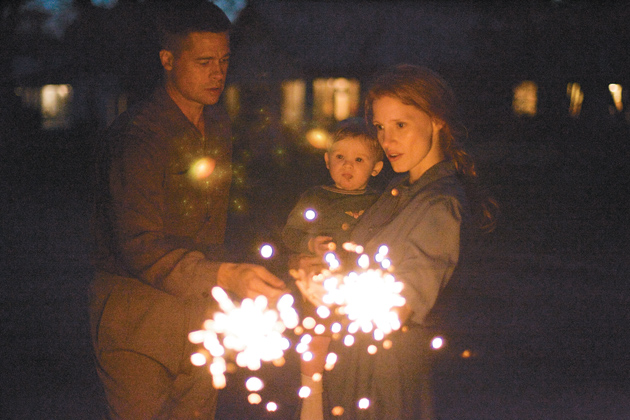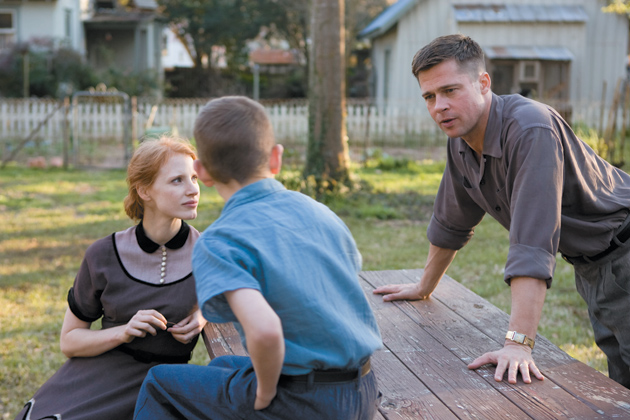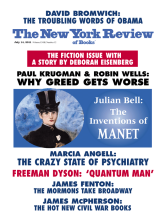In his last book William James wrote:
One need only shut oneself in a closet and begin to think of the fact of one’s being there, of one’s queer bodily shape in the darkness (a thing to make children scream at, as Stevenson says), of one’s fantastic character and all, to have the wonder steal over the detail as much as over the general fact of being, and to see that it is only familiarity that blunts it. Not only that anything should be, but that this very thing should be, is mysterious! Philosophy stares, but brings no reasoned solution, for from nothing to being there is no logical bridge.
Probably no one is currently contemplating a movie version of Some Problems of Philosophy, but Terrence Malick is the rare contemporary filmmaker I can imagine being drawn to the idea—not because he studied with Stanley Cavell at Harvard and has published a translation of Heidegger’s The Essence of Reasons, but because in all his five films and most especially the latest, The Tree of Life, he seems determined to turn narrative movies into vehicles for posing unanswerable metaphysical questions, not in words but in the quite distinct language of cinema.
In the same way that William James applies the tensile force of his logical prose toward the evocation of an imperceptible bridge beyond logic that must, somehow, be there, Malick has continued to muster the resources of film toward embodying what cannot actually be embodied. He wants to make film do what it is least able to do. Not content with showing how the world looks, he wants to show how it is experienced from the inside, even if that inside story can only be suggested through the cunning deployment of “this very thing”: this door closing, this muttered banality, this drowned body floating in a swimming pool, this wounded dinosaur, this erupting volcano, this suburban backyard, this face averted to avoid looking at another face. What he hopes to arrive at through the splicing together of such elements is something as unresolved as the stares of James’s philosophers: a suite of widescreen open questions.
The dialogue track of The Tree of Life swarms with questions, right from the start. The drifting, pleading voice-overs that provide the ground bass of The Tree of Life are not far in spirit from James’s list of “various obscure, abstract, and universal questions which the sciences and life in general suggest but do not solve,” any one of which might provide a convenient point of entry to a viewing of Malick’s film:
What are “thoughts,” and what are “things”? and how are they connected?… Is there a common stuff out of which all facts are made?… Which is the most real kind of reality? What binds all things into one universe?
The film’s portentous epigraph is the grandest question of all, God’s challenge to Job—“Where wast thou when I laid the foundations of the earth?”—the ultimate instance of answering a question with a question. Malick has never shied from grandiosity, and in The Tree of Life more than ever before he risks the humorless and overblown. Into what might in other hands have been the small-scale, melancholy tale—too elliptical even to be called a tale—of the not unusually eventful childhood of a boy in Texas, his two brothers, and his father and mother, he has managed to incorporate the creation of the universe, the origins of life on earth, the age of dinosaurs, and the prospect of future dissolution, with musical accompaniment by the powerful tonalities of Berlioz’s Requiem Mass. But he has made an audacious and magnificent film.
The extreme variations of scale are no afterthought in Malick’s scheme. To show the world in a grain of sand he must first establish what the world is. So he will walk us through the stages and conditions and outer boundaries of human existence, provide a basic introduction to annihilating and fecundating cosmic forces, move freely back and forth in time for lingering glances at birth and death and family and memory as if they were only marginally familiar phenomena, as if no one had ever done any of this before, in a movie at least—and indeed who ever did in quite this head-on fashion? He manages to make childhood (and The Tree of Life is beyond anything else a movie descriptive of childhood) seem a somewhat neglected condition, deserving of reexamination. He is continually trying out different ways of representing acts of perception: the perspective of a child looking up at the adult world, or looking down from some hidden perch, the abrupt rhythm of a child looking quickly at some terrifying outburst of adult anger and then looking away, the sheared-off gaps in editing that can mark a moment as a fresh eternity disconnected from what preceded it.
Advertisement
Malick has always shown an exact sense of what still remained to be put on a screen. He is steeped in the work of cinematic antecedents without ever seeming imitative; perhaps only a director with such a formidable awareness of formal limits could apply himself so deliberately to dissolving or transcending them. His first film, Badlands (1973), a fictionalized version of Charlie Starkweather and Caril Ann Fugate’s 1950s midwestern murder rampage, was a blast of stylistic rigor in an era trending more toward laid-back improvisation, each frame executed with painterly precision, a near-solemn exactness strangely at odds with the randomness of the protagonists’ crime spree.
With its aura of road movie nihilism, Badlands could just about fit in with other movies of its decade; its successor, Days of Heaven (1978), coming along after Easy Rider had given way to Jaws, seemed to be feeling its way toward an entirely different decade, and not just because of its period setting. The two films were very different in effect: Badlands bright and razor-sharp and profoundly opaque, a perverse marriage of the murderous and childlike; Days of Heaven, set on a farm in the Texas Panhandle, summoning up with a sort of biblical (or at least Dreiserian) splendor and gravity a pre–World War I world of unrelenting harshness and emotional isolation, complete with a plague of locusts.
Perhaps the clue was those locusts: both prophetic figures of devastation and actual creatures, pursuing their lives in intimate close-up within the 70-millimeter frame. To fold the human world into its ecosystem was to imagine a different kind of movie, keyed to different rhythms than the “beats” and “motivations” and “precipitating acts” that had by now become the industrially applied norm. The triangle drama that constituted the storyline of Days of Heaven had the rudimentary quality of an early Eugene O’Neill one-acter, stripped even of O’Neill’s dialogue. How much did one really care if Richard Gere stabbed Sam Shepard over Brooke Adams? It was a serviceable center, finally just one of the multiplicity of things going on in the world that Malick mapped with light and framing and jarring juxtaposition, with animals and landscape and weather, and with a narration disconnected just slightly enough from the images to suggest the huge gap between words and things, between inner thought and outward event.
There are moments in Days of Heaven when he seems to want not simply to pay homage to F.W. Murnau and other silent masters but to become them—not to remake their movies but to make the movies they might have fleetingly imagined, movies with the associative and digressive freedom of a long poem, too immense or open-ended for the market to bear. The long sequence near the end in which three fugitives escape downriver on a raft, the fleeting torchlit scenes of life on shore conjuring a world of danger and weird beauty, seemed to incarnate Malick’s own desire to make the screen itself a medium for escape into some further space, a fluid dimension of his own imagining. In retrospect his films seem like places that one enters rather than stories that one watches.
Malick’s reputation would be secure if he had stopped making movies after Badlands and Days of Heaven, and for twenty years he did just that, for reasons not as yet fully chronicled. (Malick has rarely given interviews and is often described in the press as “famously reclusive” or the like.) In The Thin Red Line (1998) and The New World (2005) he seemed to pick up where he left off, treating vast historical subjects (the Guadalcanal campaign and the settling of Jamestown) in a way that subordinated narrative to a swirl of subjective experience. The narrations that had featured strongly in his first two films now broadened out into a chorus of alternating inner voices almost in the manner of O’Neill’s Strange Interlude, jettisoning the sharp characterization of the earlier voice-overs for a more trancelike and disembodied tone.
The natural world now more than ever competed with human actors for screen presence. Tight framing gave way to a more exploratory approach, with the camera constantly in motion finding out unexpected pathways, moving among swamps and foliage with desperate freedom. Hyperactive editing found multiple ways to divide scenes into component fragments, to mix up the particles of the world into fresh combinations, to distend or collapse the sense of duration as needed. (Malick’s attention to editing accounts to some extent for the long gaps between his films; The Tree of Life was three years in the cutting room.) These were not movies that lent themselves to being absorbed in a single viewing. The first encounter was more like an occasion to get a rough sense of structure.
Advertisement
As many have noted, none of Malick’s earlier films got nearer to the present than the 1950s. In The Tree of Life he has belatedly—he is now in his late sixties—made contact with the contemporary world, which as represented here by the corporate towers of Houston, Texas, seems more a harbinger of some space colony from which all traces of natural ecosystems have been definitively expunged. The towers are the habitat of Sean Penn as an architect seemingly ill at ease in his world. The movie itself can be taken as his memory drama, hinging on the death of a younger brother at nineteen; the whole film might be a poem of deep grief diffused over a lifetime.
The remembered eruption of that grief—the faces of the parents as they get the news—is conveyed in sharp disjunctive fragments that give way to Fiona Shaw, as the boy’s maternal grandmother, comforting her daughter with a litany of every hackneyed phrase—“life goes on,” “you will get over this”—inevitable at such times. The delivery of these catchphrases is too heartfelt to be satirical, but they are strung together a bit too systematically to feel naturalistic. As in all that follows, the effect is of seeing a memory staged, indelible in the realism of its details but edited and compressed over time, the relevant bits run together and the dross filtered out: the world as processed by the mind, with finally only the bright bits magnetized by emotion remaining to flash against darkness.
The time remembered—the time that preceded that catastrophic loss—is the 1950s in a suburb of Waco, Texas. The elusive thread of a story concerns the early life of a boy with two brothers, a devoted but unavoidably scary father, and an adored mother. The father, wonderfully played by Brad Pitt, is a complex memory-portrait put together out of broken slivers: his bits of worldly wisdom (“the world’s gone to the dogs,” “it takes fierce will to get ahead in this world,” “the world lives by trickery”), his mass of patents for his profitless inventions, his outbursts of patriarchal rage, his final muted admission of his own inadequacies. He is a frustrated musician and we hear him, or rather Helmut Walcha in his stead, playing Bach’s “Toccata and Fugue in G Minor” on a church organ. Since this like everything else is a subjective memory, the amateur musician plays with the eloquence of a supremely accomplished musician, just as it would have sounded to his children: and the music itself is allowed to become, for the moment, the overpowering presence, the film’s characters mere auditors.
Pitt, as patriarch, is master of language: he has more lines than anyone in the film. Jessica Chastain, as the mother who (her voice-over tells us) believes in “the way of grace,” is almost wordless but no less dominant a presence, a troublingly sensual font of unlimited love and emotional permission. The quarrels between the parents are glimpsed as if a child were spying on them, or overheard as the same child walks down the street to get away from the scene. Scenes of childhood are played in brief microscopic clips that merge into dream and distorted recollection. An aroma of Freudian family romance pervades the film like a cloud of slightly acrid perfume, and Malick (who has written a screenplay on the case that formed the basis of Breuer and Freud’s Studies in Hysteria) surrounds early sense impressions with silences and gaps suggestive of Freud’s “screen memory” that conceals another adjacent memory. Every view is partial, every glimpse interrupted.
The sense of temporal progression melts into the timelessness of the childhood house, as the same domestic interior spaces are seen again and again in different framings, at different hours, at different ages. Malick evokes, almost as a byproduct, an impressionist collage of a 1950s childhood—the mother reading from Kipling’s Jungle Book at bedtime, the boy drinking water from a garden hose, the children playing in the clouds sprayed from a DDT truck—without heavy reliance on pop hits or news items. But any nostalgic yearning stirred up by his vision of dusky summertime paths is shot through with intimations of pain and uneasiness. The world into which his characters set out, even if it is only the backyard, is a tentative place, every seeming refuge also a potential trap.
The boy Jack, who will grow up to be Sean Penn, and who is played as persuasively as can be imagined by Hunter McCracken, lives through the early storms of rage and guilt and desire with the foreboding of someone to whom something utterly strange and unheard of is happening, whether he is defiantly smashing a window or contemplating the murder of his father as he watches him at work under the jacked-up family car or stealing a bit of lingerie from a woman’s drawer and setting it adrift on the water. It occurred to me watching the film that this kind of intense evocation of the barely subdued terrors of childhood is more commonly found in horror movies—The Shining or The Sixth Sense—but here no Gothic melodrama or extraordinary bursts of violence are needed to convey the tremors under the surface of ordinary life.
In place of the spooky fears of melodrama Malick proposes the existential dread of cosmology. He can’t show the life of this boy unless he shows you his parents; and the time and place where the parents lived; and the planet on which that era unfolded; and the universe in which that planet came into existence, and within which it will meet its end. We are shown wonder upon wonder—the swirling inner lives of stars and cells, the explosive violence of the process out of which life somehow emerged—in a wordless movie within the movie, although the question of what exactly is “within” anything else becomes very much a moot point.
The complex effects designed by Douglas Trumbull (Kubrick’s collaborator on 2001: A Space Odyssey) and others, fusing the real, the painted, and the digitally generated, are extraordinary in themselves—a tantalizingly brief glimpse of life in the age of dinosaurs for a few moments takes precedence over everything else in the film—but more so for the way their gigantism inflects the whole film, so that the human sense of proportion geared to our frame and lifespan is juxtaposed with other scales. But this too is closely bound to the mapping of the mind of childhood, particularly of a 1950s childhood filled as a matter of course with imaginings of dinosaurs and exploding stars. The boy dreams of the universe that dreamt him up in the first place: and it is no dream at all but the very reality, fluid and tenuous, that we spectators inhabit. The possibility of the disappearance of everything is held in constant view. “We vanish as a cloud,” a minister flatly intones in a moment plucked out of a church service.
For his ending Malick has contrived a curious allegory of time—a sort of masque, almost—in which all the characters, at all their different ages, coexist in a single moment. It is a stylized restatement of what has already been implicit in every aspect of The Tree of Life: the notion that every moment exists in the present, whether it is the moment when an asteroid collides with a planet or the moment when a boy breaks a window, and that the whole of imaginable time can be only one great now.
This is the droning note that underlies the play of color and texture and metamorphosing forms, the surges of painful emotion that are understood as natural ripples of a kind with waves and clouds. Made with obsessive precision in all its parts, The Tree of Life is nonetheless not a neat movie. Malick is neither neat nor witty nor dry the way one might want so philosophically ambitious a filmmaker to be. But while I would not rush to read a verbal summation by Malick of his philosophical views, I would burn with irresistible curiosity to see the film of any text he might care to adapt, whether it were Spinoza’s Ethics or the phone book. He does his thinking by means of cinema in its full range of possibilities, and that is at any time a rare spectacle.
This Issue
July 14, 2011
The Illusions of Psychiatry
The Busts Keep Getting Bigger: Why?





